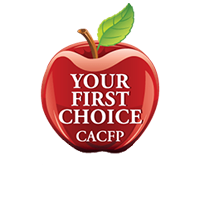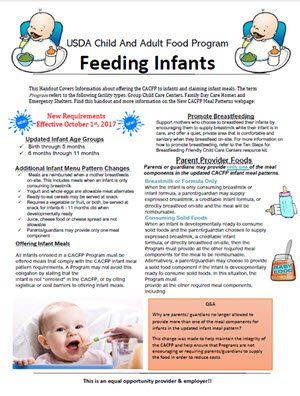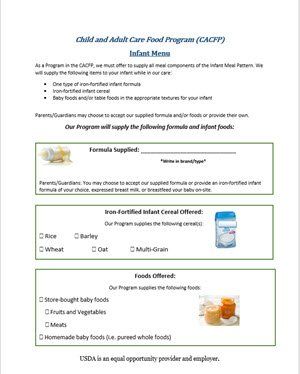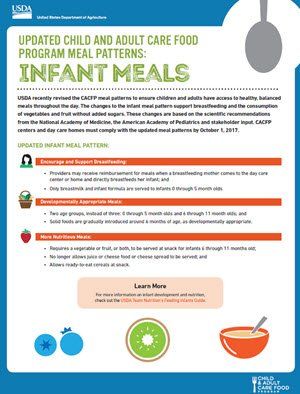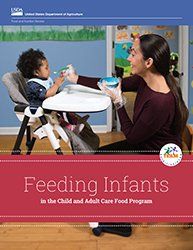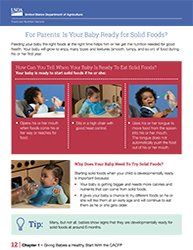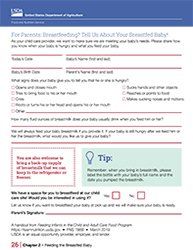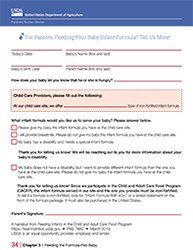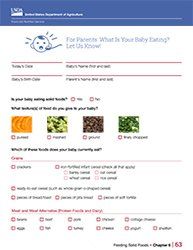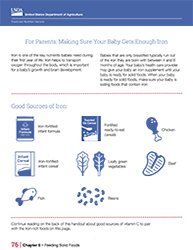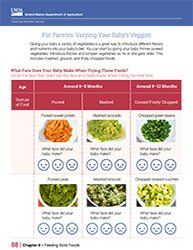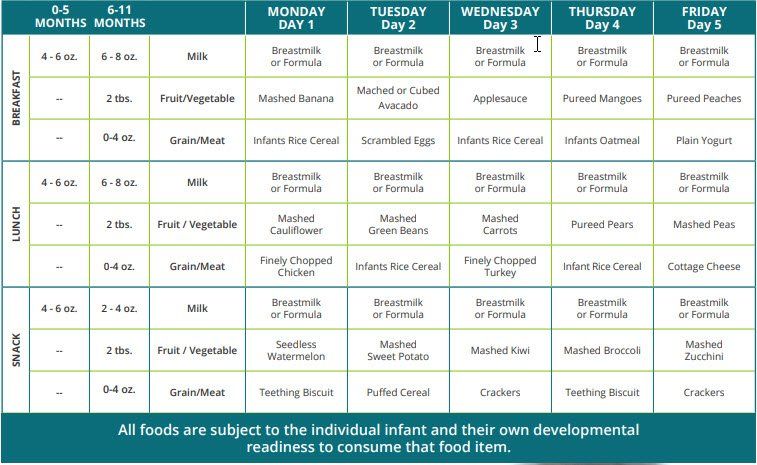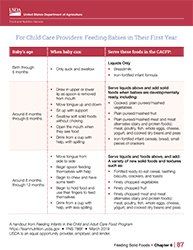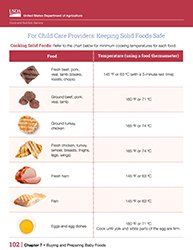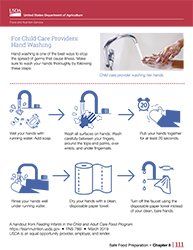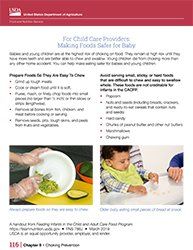Feeding Infants

FEEDING INFANTS
CACFP Infant Meal Pattern
CACFP infant meal pattern age groups encourage delaying the introduction of solid food until the infant is 6 months. However, the age when solid foods are introduced will depend on the infant. Infants develop at different rates - some infants are ready to consume solid foods before 6 months of age and others are ready after 6 months of age.
Food amounts listed in the meal pattern begin with zero (0) because USDA recognizes that not all infants are developmentally ready to eat solid foods at a certain age. It does not mean serving the food is optional. Once an infant is developmentally ready to eat solid foods, including infants younger than 6 months, programs are required to offer them to the infant.
BREAKFAST/LUNCH/SUPPER
Birth through 5 Months
4-6 fluid ounces breast milk, iron fortified infant formula, or portions of both
6 months through 11 months
6-8 fluid ounces breast milk
AND
ONE OR MORE OF THE FOLLOWING:
- 0-4 tablespoons iron fortified infant cereal
- 0-4 tablespoons meat, fish, poultry, whole egg, cooked dry beans or cooked dry peas
- 0-2 ounces of cheese
- 0-4 ounces (volume) of cottage cheese or yogurt
AND
- 0-2 tablespoons vegetable, fruit or a combination of both (no juice)
*Grain items (i.e. bread, pancakes, waffles, breakfast cereal, etc. are not creditable foods at breakfast, lunch and supper in the infant meal pattern. They cannot be served in place of IFIC.
ADDITIONAL REQUIREMENTS
- Breastfed infants who consume less than the minimum amount of breast milk per feeding may be served less than the minimum with additional breast milk offered later if the infant will consume more.
- Yogurt must contain no more than 23 grams of total sugars per 6 ounces.
- Grains served at snack must be whole grain-rich, enriched meal, or enriched flour.
- Breakfast cereals served at snack must contain no more than 6 grams of sugar per dry ounce.
SNACK
Birth through 5 Months
4-6 fluid ounces breast milk, iron fortified infant formula, or portions of both
6 months through 11 months
- 2-4 fluid ounces breast milk, iron fortified infant formula, or portions of both
AND
ONE OR MORE OF THE FOLLOWING:
- 0-½ slice bread;
- 0-2 crackers
- 0-4 tablespoons iron fortified infant cereal or ready-to-eat breakfast cereal
AND
- 0-2 tablespoons vegetable, fruit or a combination of both (no juice)
*Grain items (i.e. bread, pancakes, waffles, breakfast cereal, etc. are not creditable foods at breakfast, lunch and supper in the infant meal pattern. They cannot be served in place of IFIC.
ADDITIONAL REQUIREMENTS
- Breastfed infants who consume less than the minimum amount of breast milk per feeding may be served less than the minimum with additional breast milk offered later if the infant will consume more.
- Yogurt must contain no more than 23 grams of total sugars per 6 ounces.
- Grains served at snack must be whole grain-rich, enriched meal, or enriched flour.
- Breakfast cereals served at snack must contain no more than 6 grams of sugar per dry ounce.
Feeding Infants
Feeding Infants in the Child and Adult Care Food Program (CACFP) guide is a training tool for CACFP operators with infants enrolled at their childcare site. It covers topics such as the infant meal pattern, developmental readiness, hunger, and fullness signs, handling and storing breastmilk and infant formula, solid foods, what is creditable in the infant meal pattern, and much more. Find parent communication tools, childcare provider handouts, practice scenarios, and check your knowledge questions in this guide as well.
Availability: ENGLISH or SPANISH. Printed materials are available only to schools, childcare providers and summer meal programs participating in one of USDA’s child nutrition programs. All are welcome to download these materials and make copies. If you have difficulty opening any of these files in your Internet browser, please right-click on the link and “save target as…” to download.
Communication Tools For Parents
-
Is Your Baby Ready for Solids?
Is Your Baby Ready for Solids?How to determine if your baby is ready for solids.
-
Breastfeeding? Tell Us About It.
Breastfeeding Information WorksheetTell us about your breastfed baby.
-
Feeding Infant Formula
Feeding Baby Infant Formula WorksheetTell us about your baby's infant formula.
-
What Is Your Baby Eating?
What Is Your Baby Eating WorksheetWorksheet to show what your baby is eating.
-
Enough Iron for Baby?
Making Sure Your Baby Gets Enough IronMaking sure your baby gets enough iron.
-
Varying Your Baby's Veggies
Varying Your Baby's Veggies WorksheetGuidelines for varying your baby's vegetables.
Sample Infant Cycle Menu
Here is a sample cycle menu for infants, 6 to 11 months old, to help you plan your calendar with creditable recipes that meet the New Meal Pattern guidelines.
IMPORTANT INFO ABOUT BABIES
- Breastmilk or formula, or portions of both, must be served; however, it is recommended that breastmilk be served in place of formula from birth through 11 months. For some breastfed infants who regularly consume less than the minimum amount of breastmilk per feeding, a serving of less than the minimum amount of breastmilk may be offered, with additional breastmilk offered at a later time if the infant will consume more.
- Infant formula and dry infant cereal must be iron-fortified.
- Beginning October 1, 2019, ounce equivalents are used to determine the quantity of creditable grains.
- A serving of grains must be whole grain-rich, enriched meal, or enriched flour.
- Breakfast cereals must contain no more than 6 grams of sugar per dry ounce (no more than 21.2 grams sucrose and other sugars per 100 grams of dry cereal).
- Fruit and vegetable juices must not be served.
Breastfeeding
Learn how you can support breastfeeding at your child care.
https://www.fns.usda.gov/cacfp-halftime-how-support-breastfeeding-cacfp
The CACFP Halftime: Thirty on Thursdays webinar series is a set of monthly interactive, skills-building webinars that focus on hot topics related to the updated Child and Adult Care Food Program (CACFP) meal patterns. This webinar focuses on how child care centers and family child care homes that participate in the Child and Adult Care Food Program (CACFP) can support reastbfeeding. To receive a certificate of participation after viewing this webinar, please visit:
https://www.cacfp.org/resources/thirty-thursdays/
and complete the post-webinar practice questions. It may take a few days to receive your certificate.
Helpful Presentations
Communication Tools For Providers
-
Feeding Babies First Year
Feeding Babies First YearGuide for child care providers for feeding babies.
-
Keeping Solid Foods Safe
Keeping Solid Foods SafeHow to keep solid foods safe in child care.
-
Proper Hand Washing
Learn About Hand WashingLearn proper hand washing with young children.
-
Making Foods Safer in CACFP
Making Foods SaferDecrease choking hazard with this handy guide.
How does it work?
All paperwork is completed daily by hand or online, which makes up your monthly claim. All claims are to be mailed or emailed into the office on the first working day of the month to be processed. Your reimbursement check will be mailed on the last day of the month, unless the 1st is on Sunday, providing the funds are available from the state. It is that simple.
This Institution is an equal opportunity provider.
115 N. 7th | Salina, KS 67401
Toll Free: 877-385-3555
This Institution is an equal opportunity provider.
© 2024
All Rights Reserved | First Choice Support Services| Website Design by Marketing Angle

